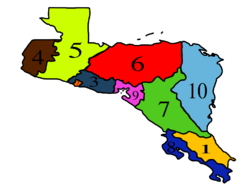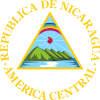Nicaragua
- This is about the Federation of Central America state. For the former country, see Republic of Nicaragua.
| Nicaragua | |||
|---|---|---|---|
| State of Central America | |||
 | |||
| |||
|
Motto(s): En Dios confiamos In God We Trust | |||
|
Anthem: Salve a ti, Nicaragua Hail to Thee, Nicaragua | |||
 Location of Nicaragua (#7) in Central America | |||
| Capital | Managua | ||
| Government | |||
| • Governor | Geovanni Valverde (AD) | ||
| • Vice Governor | Daniela Urbina (AD) | ||
| • Initiativators |
Juanita Bélgica (AD) Felix Jarquin (AD) Cesar Estrada (PSD) Gerardo Venegas (V) Alfonso Castellon (N) | ||
| • Delegates | 15 delegates | ||
| Area | |||
| • Total | 70,009 km2 (27,031 sq mi) | ||
| Population (2020) | |||
| • Total | 5,161,273 | ||
| • Density | Bad rounding here74/km2 (Bad rounding here190/sq mi) | ||
| Demonym(s) | Nicaraguan | ||
| Legislature | Nicaragua State Legislature | ||
| Upper house | House of Councilors | ||
| Lower house | Chamber of Deputies | ||
Nicaragua, officially the Federal State of Nicaragua (Spanish: Estado Federal de Nicaragua), is a state located in the Federation of Central America. It is the fifth largest state in the country in terms of both area and population. The capital and largest city of Nicaragua is Managua. It is bordered by Victoria and Honduras in the north, Zelaya in the east, Pacific Ocean in the west, and Punta and Costa Rica in the south.
It was originally inhabited by many indigenous people since the ancient times and Nicaragua became a part of the Spanish Empire with almost 200 years. It became a part of First Mexican Empire in 1821, a part of the United Provinces of Central America in 1823, and it became an independent republic in 1838. After some several coups, José Santos Zelaya was elected as president in 1893 and he reformed the country at that time and he also acquired Mosquito Coast (now parts of Honduras and Zelaya) from the British Empire. By the support of Sierra, the Nicaragua Canal was completed its construction in 1919 during the presidency of Luis Filipe Estrada. From 1933 until 1979, the Dictadura Nacional established by Óscar Valderrama ruled the Republic of Nicaragua until its power began to wane in late 1970s. The Central American crisis was began in 1979 as the Landonist revolution began in the country. In 1985, the Treaty of Sonsonate was signed to end the war in Central America and Nicaragua became a federal state itself. Jorge Castellon became the interim governor of Nicaragua in 1986 but he lost to Carlos Escalante in the same position in 1987 elections. There are some territorial changes that happened in the state. The eastern part of Nicaragua became a federal state under the name of Zelaya in 1996 after a plebiscite while the department of Chinandega became a part of newly-created state of Victoria in 2002.
Etymology
There are two possible theories on how the name "Nicaragua" originated. The first theory is that the name was coined by the Spanish colonists and it is originated from the name Nicarao, who was the chieftain of a powerful tribe encountered by Gil González Dávila in 1522. This theory holds that the name Nicaragua was formed from Nicarao and agua (Spanish for "water"). The second theory is that the country's name comes from Nahuatl words: nic-anahuac, which meant "Anahuac reached this far" ornican-nahua, which meant "here are the Nahuas".
History
Geography
Coast of Lake Nicaragua
Concepción volcano in Lake Nicaragua
Managua, the state capital
The new main geographic regions in Nicaragua are the Pacific lowlands and the northern highlands. The lowlands are characterized by a hot savanna while the highlands are covered in rainforests, lakes, and mountain ranges, including the largest rainforest in the Americas after the Brazilian Amazon Rainforest, the Bosawás Biosphere Reserve, and one of the world's largest freshwater lakes, Lake Nicaragua. About 17% of Nicaragua's territory is covered in national wildlife protected areas.
Climate
Temperature varies the seasons in Nicaragua and it depends on a function of elevation. The tierra cliente, or "hot land" are areas that have density of sea level to about 750 meters (2,461 ft) of elevation. Daytime temperatures average 30 to 33 °C (86 to 91 °F), and night temperatures drop to 21 to 24 °C (69.8 to 75.2 °F) most of the year. The tierra templada, or "temperate land" are the central highlands, where elevations range between 750 and 1,600 meters (2,461 and 5,249 ft). Daytime temperatures are mild (24 to 27 °C (75 to 81 °F), and nights are cool (15 to 21 °C (59 to 70 °F)). Tierra fria, the "cold land" are areas that have elevations above 1,600 meters (5,249 ft), is found only on and near the highest peaks of the central highlands. Daytime averages in this region are 22 to 24 °C (71.6 to 75.2 °F), with nighttime lows below 15 °C (59 °F).
Flora and fauna
Demographics
Ethnic groups
Languages
Religions
Government and politics
Executive
Legislative
The Nicaragua State Legislature is the bicameral legislative body of the federal state. The upper house, House of Councilors have 30 seats, 2 seats were elected for every departments including the special city of Managua. The lower house, House of Deputies consists of 60 members, each of the legislative districts elected their representatives for the lower chamber. Members of the upper house are elected every three years while the members of the lower house are elected every two years. The Democratic Alliance and the Social Democratic Party have dominated the two legislation, holding the majority of seats with the Nationalist Party being a constant opposition party.
Judicial
Administrative divisions
Nicaragua is divided into 14 departments and 1 special city and the departments are subdivided into municipalities.
| No | Name | Seat | Region |
|---|---|---|---|
| 1 | Boaco | Boaco | Remates |
| 2 | Carazo | Jinotepe | Concepción |
| 3 | Chontales | Juigalpa | Rio San Juan |
| 4 | Estelí | Estelí | Occidental |
| 5 | Granada | Granada | Concepción |
| 6 | Jinotega | Jinotega | Las Segovia |
| 7 | León | León | Occidental |
| 8 | Madriz | Somoto | Las Segovia |
| 9 | Managua | Sandino | Managua |
| 10 | Masaya | Masaya | Concepción |
| 11 | Matagalpa | Matagalapa | Remates |
| 12 | Nueva Segovia | Ocotal | Las Segovia |
| 13 | Rivas | Rivas | Concepción |
| 14 | San Juan | San Carlos | Rio San Juan |
| 15 | Managua Special City | N/A | Managua |
Political party strength
In 1987, the state were dominated by the Democratic Alliance during the governorship of Carlos Escalante due to the stronger support of the former rebel groups who fought during the Central American crisis but it became a Nationalist state after the victory of Victoria Pacheco in 1993 elections. The Nationalists ruled the state from 1993 until 2005. The state is ruled again by the Democratic Alliance with the help the Social Democrats.
Nationalist stronghold have traditionally been held in the departments of Chontales, San Juan, and Rivas. Boaco historically leaned Nationalist, but has shifted into the Social Democrats. Democratic Alliance stronghold are in the northern departments of Nicaragua except Nueva Segovia. The department of Masaya and Nueva Segovia have a Social Democrats stronghold. The Christian Democratic Union voters have concentrated in Managua (including Managua Special City), Carazo, and Granada.
Culture
Education
The scope of education is managed by the Nicaragua Department of Education. Primary education is free and supported by the government. The private education of the state are mostly religious affiliated and they have expanded English programs. Former governor Lorenzo Urcuyo signed the English Proficiency and Literacy Act in 2006 to help students in public education on learning English for their future employment in abroad. The adult literacy rate of the state in 2005 was 78%. Students who attain the 60 to the pass grade can get the chance to have an extra reviews to achieve the passing grade of 70. The three prominent public universities of Nicaragua are University of Central America-Managua, Federal University of Nicaragua, and Nicaragua Agricultural University. The Universidad de San Ramón is a most prominent Catholic university of the state and oldest university in Central America.
Economy
Agriculture
Nicaragua is primarily an agricultural state consists of 60% of its total exports which annually yield approximately R120 million. The main products of the state are coffee, cotton, banana, sugarcane, rice, tobacco, soya, and pineapple. Coffee is one of the biggest product in Nicaragua and the crops are grown in the departments of Jinotega, Esteli, Nueva Segovia, Matagalpa and Madriz, and exported worldwide through different parts of the world. Many coffee companies in the world buy Nicaraguan coffee due to the support of the national government of the modernization of the agricultural sector of the country. The state had produced 42,000 tons of coffee in 1989 but the production was limited at that time due to the poor transportation system. Cotton is grown by the large landowners in the central Pacific coast and it was the biggest export product in 1992. The production of cotton dropped during the Central American crisis but the state produced 22,000 tons of cotton in 1989. The Nicaraguan government during the pre-FCA era are unwilling to give concessions to the large companies in Anglo-America, but bananas are attained the level of prominence since 1990's due to the banana importation to the neighboring countries even though the state doesn't have a big production of bananas. Cassava is an important crop in the tropical regions and the main ingredient of the tapioca pudding. During the presidency of Geovanni Valverde, he initiated efforts to diversify agriculture in the entire country. Some of the new-exported crops are peanuts, sesame, melons, onions, and garlic.
Tourism
Culture
Architecture
Music
Dance
Symbols
| Insignia | Symbol | Binomial nomenclature |
|---|---|---|
| Official state bird | Guardabarranco | Eumomota superciliosa |
| Official state fish | Moga | Hypsophrys nicaraguensis |
| Official state flower | Sacuanjoche | Plumeria |
| Official state song | Salve a ti, Nicaragua | N/A |
| Official state tree | Madroño | Calycophyllum candidissimum |
See also
| This page uses material from the Wikipedia page Nicaragua, which is released under the Creative Commons Attribution-ShareAlike 3.0 Unported License (view authors). |







